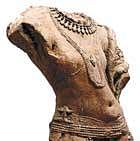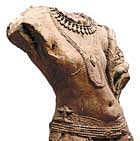

A 50-strong group of four-year-old children sit huddled in front of a painting, the teacher merely in attendance and not explaining the large geometric patterns of the abstract canvas. No, this is not a scene from Alice in Wonderland, but a regular art appreciation activity for school-going children in Madrid, who in this case, are visiting the Reina Sophia museum in Madrid. Other museums abroad similarly attract not only tourist attention but are places to ponder and revel in the country’s art and culture heritage even for the local people.
In India, however, art is normally considered arcane or pretentious by the common man, and museums in our country have done little to attract people despite having some of the finest collections of artefacts in the world. “People will visit museums only if they have an emotional attachment to their heritage,” says Shailin Smith, museologist and art consultant. “We are more interested in creating a hype about other countries and seek endorsement from outside. To make matters worse, our museums are built on a borrowed western ideology and a common viewer feels no connect with a sterile and decadent building. I will step into a museum only when I find something related to me.”
While Smith may have a point there, with the fact being that India never had an indigenous museum culture and every household doing its own bit to produce and preserve an artefact, cultural historian and museologist Jyotindra Jain begs to differ. “It is logical that we have had to follow a foreign model of acquisition, display and conservation but there is nothing wrong with that. Why our museums are empty, despite the surplus and unused funding, has other reasons.”
Lack of trained museum personnel is one of the biggest sore points with Jain. For the last 15 years, an average of 15 to 20 per cent of positions, both Class I and Class II, are lying vacant in cultural institutions across the country. Recruitment procedures are obsolete and do not take into account the changing art and culture scenario of the country. Those having trained in non-mainstream subjects like cultural and visual studies, cinema or performance art, are rejected at the application level itself. Add to that, art being at the lowest rung in government’s priority list, and you have a situation like the National Museum in Delhi where the post of a director has not been filled up for the last two years since the demise of the last director.
“There are no jobs for people like us,” laments Smith, who did a course in museology from National Museum Institute, New Delhi. “Those at the top refuse to give way until they retire and younger positions are never advertised or promoted,” she adds.
What we need is a complete revamp of our museology course to attract youngsters into the stream, offers Jain. “We should at least now include conservation, museum studies, curatorial practice, museum management and even lighting and display as part of the course. Those who come to work in museums now are not specialists and hardly equipped to infuse freshness into the system.”
Like every other industry, especially those in the creative field, the vision with which a young person can at least attempt to change the falling standards is — according to Jain — to make our museums viewer friendly. “Compare art and culture to cinema, or even fashion,” says Smith, “the government will go all out to host an event by FDCI, but when it comes to art, there is just no fast track movement.” What is needed at the policy making level, is to change the very notion of how art is defined. “Photography, video and new media should be part of our museum collections and at the bureaucratic level, young and fresh blood needs to be accepted and nurtured before the museums become museumised,” says Jain.
A dearth of interesting events that draw public attention to museums is another problem echoed by art watchers. In Delhi, for instance, the only show at National Museum that has generated any buzz in the last few years is that of the Nizam’s jewels. The National Gallery of Modern Art, is more well organised, but falls back on mostly cross-border cultural exchanges and little or no emphasis is given to its permanent collection.
General opinion amongst art watchers is that every museum should have at least two major and two minor shows every year which keep the local interest in museums alive, while also paying an equal attention to their permanent collection, which are either displayed in a nondescript manner or dusted and put up for a boring show that no one seems interested in. “Where are the curators?” asks art historian Bhavna Kakar, “government museums are always hesitant to seek external help. Just putting up masters’ paintings won’t attract the crowd.”
Having just come back from Paris after curating a show on folk and tribal art, the former director of Crafts Museum and now Member Secretary IGNCA, Jain reflects on the success of his French outing to admit that Indian museums rarely ask art experts and curators to create theme-based shows. “A curator can do wonders with different aspects of the museum’s permanent collection. Each section has its own history and relevance and a curator can find its connect for the masses. Merchandise connected with our history should be easily available and promoted through such curated effort. Sadly, the relationship between museums and professional curators is that of animosity. If only we could change this, the entire system could be overhauled.”
Shows that are indeed put up at museums are hurried jobs (“it took me three years to plan the show in Paris,” says Jain) and often put up to celebrate the presence of a visiting foreign dignitary. While the common perception is that our museums are not happening places to visit, what compounds the problem is that there is no concerted effort to make new acquisitions that might create a media blitzkrieg leading to public interest.
Few would perhaps know that the Art Acquisition Committee at Delhi’s National Museum has been lying defunct and for nearly two decades now, new purchases have been banned because of a spurious jewellery purchase few years ago. Moreover, our antiquity law is also antiquated. If someone wants to give the government a priceless artefact they have found or want to part with, chances are they will be put behind bars. No wonder, most of our new finds sail their way abroad either legally or illegally.
The discontent is evident even within museum walls. “Where is the space to display more,” says KK Deori, curator, at National Museum in Delhi, “the third section of the museum that was to come up has been given to the Archaeological Survey of India. More than 80 per cent of our stock is in storage, most of the administrative posts are unfilled and there is not a single security personnel in a department that once boasted of over 50 people!”
Unnerving statistics even for a pessimist, but proves yet again that bureaucracy and art rarely go together, with files after files having to be cleared for simple decisions. It’s not uncommon knowledge that in an attempt to revitalise NGMA, Mumbai, which attracts far fewer visitors than the Prince of Wales Museum across the street, the Nanavati Charitable Trust (of Nanavati hospital fame) in Mumbai offered to give the NGMA a gift store and a cafeteria but even after a series of plans and approvals, the government developed cold feet about private enterprise in its art fiefdom.
At least some of this seems set to change with the Union government waking up from its slumber, even if the wake up call is for the Commonwealth Games. Nine of our largest museums — Delhi’s National Museum and National Gallery of Modern Art, Kolkata’s Indian Museum and Victoria Memorial, Hyderabad’s Salar Jung Museum, Allahabad Museum, Bhopal’s Museum of Mankind, Mumbai’s Chhatrapati Shivaji Maharaj Vastu Sangrahalaya (formerly Price of Wales Museum) and Chennai’s Egmore museum — have been shortlisted for a revamp and reform, covering aspects like collection management, security, conservation, visitor facilities, museum shops and development of personnel.
Sceptics are still not happy though. “They will take years to move the files,” says Kakar, reflecting on the current developments, “and the only alternative is private museums, or even a public-private-partnership for developing a far more vibrant art scene.”
One of the recent examples of a private museum is Anupam Poddar’s Devi Art Foundation in Gurgaon, Haryana. While their collection may be limited to what some euphemistically call “radical” art, there’s no doubt that it has fast gained prominence in the capital city. HCL Technology’s Kiran Nadar Museum of Art is another example. The country will soon see more private museums, notably Osian’s Neville Tuli’s Osianama and Kolkata’s Rakhi Sarcar (of CIMA Art Gallery) is planning to open Kolkata Museum of Modern Art as a triangular private-public partnership in 2013. In the South, sugar baroness, Rajashree Pathy has launched the Coimbatore College of Contemporary Art to foster awareness through outreach programmes.
Jain has yet another vision to offer: “I have suggested the concept of Museum Islands to the Secretary, Culture. So many collectors want to come together and start museum complexes showing their private collection. It would be a win-win situation as their identity is retained and costs are shared. All they would need for the government to do is give approvals if not benefits.”
While Jain is optimistic about his proposal floated on World Museum Day at Sanksriti Foundation in New Delhi, one hopes this does not languish in more files at Shastri Bhavan.